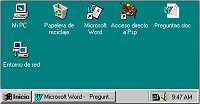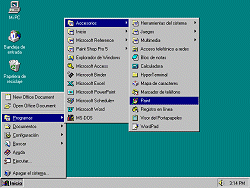Software is the set of programs or instructions that start up the computer and process data so tha we can use it.
The instructions in the programs are written in programing languages. There are several types of programs. Each one performs a specific function:
- A) OPERATING SYSTEMS. This is the core program that tells the computer how it should perform all its basic funcions, eg. displaying the character on the screen, printing information or recording information on a disc. It enables the comunication between the hardware and the the programs with the user, therefore it is an ``interfaz``. The OS is loaded from the HD and stored in the RAM memory, where it remains until the computer is turned off. Nowdays you can open different windows and work with several files and programs at the same time (it is called Multi-Task System). Another type of operating system is the LINUX, it can be used, improved and shared at no cost.
- B) APPLICATION. An office software suite is the group of programs used to organise, store and process data, as well as trnansmit information. The mos frequently programs are word, spreadsheets, database management systems and presentations programs (e.g. the programs that belong to the Microsoft Office Package).
- MULTIMEDIA PROGRAMS to process text, images, animation, sound, etc.
- PROGRAMING LANGUAGES to create another programs and applications: Java, C++, VisualBasic, etc.
ACTIVITY Nº1.
a) Do you think it is possible to run a program on a computer without an operating system? Give reasons about your answer.
b) List four or more types of operating systems?
Windows 8: Is the current version of Microsoft Windows operating system produced by Microsoft for use on personal computers, including home desktops and business laptops, netbooks, tablets, servers and multimedia centers.
Solaris: Solaris operating system created by Sun Microsystems.
GNU Hurd: GNU Hurd is a set of server programs that simulate a Unix kernel that provides the basis of the GNU operating system. The GNU Project has been developing as free software, distributing it under the GPL.
Irix: Is a Unix-compatible operating system, created by Silicon Graphics for 64-bit MIPS platform.
Linux: Linux is a free operating system kernel based on Unix. [3] is one of the leading examples of free software.
GNU Hurd: GNU Hurd is a set of server programs that simulate a Unix kernel that provides the basis of the GNU operating system. The GNU Project has been developing as free software, distributing it under the GPL.
Irix: Is a Unix-compatible operating system, created by Silicon Graphics for 64-bit MIPS platform.
Linux: Linux is a free operating system kernel based on Unix. [3] is one of the leading examples of free software.
BeOS: Is a PC operating system developed by Be Incorporated, mainly oriented to provide high performance in multimedia applications.
c) What are the items that you can see on the desktop (eg.icons)?
The large area is seen in the upper part of the screen is called desktop. Sometimes, the term can be used to refer to Desktop everything you see on the monitor when you boot Windows.c) What are the items that you can see on the desktop (eg.icons)?
The main purpose is to keep the Desktop icons there shortcuts or shortcuts to help you work with greater efficiency.
The Desktop
Taskbar

Desktop Icons
Shortcuts
d) How many computer icons do you know?
All who are in the previous activity.
e) Make a table where you can compare the aplications of the Windows Office Package with the Open Office Package.
f) Make a table where you can compare the differences between the Windows OS and the Linux OS.
f) Make a table where you can compare the differences between the Windows OS and the Linux OS.
ACTIVITY Nº2.
a) What´s MATRIX? Is it a program or a machine? Explain it.
a) What´s MATRIX? Is it a program or a machine? Explain it.
The movie is that life is a computer program and that people are manipulated.
The machines have undergone humans asleep in a trays keeping them connected to a false
dream world from a computer program called Matrix.
b) Write down 3 features of an Operative System.
Convenience: An operating system more convenient to use a computer.
Efficiency: The operating system allows computer resources are used properly and
efficiently.
Ability to envolve: An operating system must be able to accept new features without having problems.
c) Write down one example of an “Operative Multi-Task System”.
Another example is the Windows operating system, you can run multiple programs simultaneously.
d) Describe the differences between an Operative System of Commands and one of Graphics Interface.
-Graphical User Interface (GUI)
Commands are represented by icons, buttons or other graphical elements. The mouse is the
primary tool to interact with them. Interface is standard today.
-Line Interface (CLI)
The user must enter the commands by typing them line by line with a particular format. This
interface is the older operating systems such as MS-DOS.
Command line interface of MS-DOS
3.2. WORKING WITH AN OPERATING SYSTEMS
The Operationg Systme enables communication between the hardware and the programs. The OS is loaded from the hard drive and stored in the RAM, where it remains until computer is turned off.
When you turn on the PC, it automatically loads the OS, which allows you to see a screen called the "desktop".
On the desktopo you can find different "icons" which links with different applications, files or folder.
With the OP you can open different windows and work with several files and programs at the same time. All windows have a title bar, a status bar, a control menu, a toolbar, a work area, a scroll bar and several buttons with different functions.
The datas are stores as files and to organise the amount of them you can use folders. The drives are where the information is stored, organised into files and folders.
Each file has a name, an extension and an associated icon to tell us the type of information stored inside. You can look for it by using Windows Explorer.
If you right-click on a file or folder, you can access a menu that will enable you to cut,copy, paste, delete or change the name or that file or folder.
When a file is too much memory you can compress it. Data compression, source coding or bit-rate reduction is the process of encoding information using fewer bits than the original representation would use.
Compression is useful because it helps reduce the consumption of expensive resources, such as hard disk space or transmission bandwidth.
The Operationg Systme enables communication between the hardware and the programs. The OS is loaded from the hard drive and stored in the RAM, where it remains until computer is turned off.
When you turn on the PC, it automatically loads the OS, which allows you to see a screen called the "desktop".
On the desktopo you can find different "icons" which links with different applications, files or folder.
With the OP you can open different windows and work with several files and programs at the same time. All windows have a title bar, a status bar, a control menu, a toolbar, a work area, a scroll bar and several buttons with different functions.
The datas are stores as files and to organise the amount of them you can use folders. The drives are where the information is stored, organised into files and folders.
Each file has a name, an extension and an associated icon to tell us the type of information stored inside. You can look for it by using Windows Explorer.
If you right-click on a file or folder, you can access a menu that will enable you to cut,copy, paste, delete or change the name or that file or folder.
When a file is too much memory you can compress it. Data compression, source coding or bit-rate reduction is the process of encoding information using fewer bits than the original representation would use.
Compression is useful because it helps reduce the consumption of expensive resources, such as hard disk space or transmission bandwidth.
ACTIVITY Nº3
PRACTICE WITH YOUR COMPUTER DOING THE FOLLOWING TASKS, WRITE DOWN THE RESULT ON YOUR BLOG.
3.1.Change the date of your computer and create a folder. Change back the correct date and create another folder. Check the difference between both dates.
3.2. Look at the menu “start>program” the application for the calculator and open it. Work on it with the following examples:
a) Square root of 9 =3
b) (25+7)*15 =480
c) Binary of 25 =11001
3.3. Find out in “start>my PC>properties” the features of your gear:
a) Size of the Hard Disk
b) Capacity of the RAM Memory. 2.71 GHz y 1,87 GB de RAM
c) Type of Operating System.
d) Type of microprocessor.
e) Speed of microprocessor.
f) Name of your PC.Alumno 2
g) Name of your NET.Tegnología
3.4. Change the “background” of your desk top with another image of Windows.
3.5. Check the last files that exist in your computer: C:\Documents and Setting\User\Recent
3.6. Open a folder and show the files in order: first by name and then by modification date.
3.7. Create a file with the text processor, erase it and then recover it using the “Recycle bin”
3.8. Go to the “Recycle bin “and erase a file permanently (be careful in this operation)
3.9. Check in your computer how many users there are. Administrator and guest.
3.10. Find out what IP your computer has. Go to “start>accessories>Symbol of the system” and type IPCONFIG. 10.120.49.152
3.11. Find out how many printers your computer has: “start>control panel” OneNote 2007
3.12. Look at the meaning of “IP address” in Wikipedia. Copy the text and paste it on a new document of MS-Word.
a) Select the whole text and format it with “ARIAL” font, and size “14”.
b) Align the paragraph in the center.
c) Set automatic number to the different paragraphs.
d) Look at “IP address” in the GOOGLE IMAGE SEARCH and copy it on the document.
An Internet Protocol address (IP address) is a numerical label assigned to each device (e.g., computer, printer) participating in a computer network that uses the Internet Protocol for communication.[1] An IP address serves two principal functions: host or network interface identification and location addressing. Its role has been characterized as follows: "A name indicates what we seek. An address indicates where it is. A route indicates how to get there."
3.13. Save the previous document with the name IP and compress it using WinRAR (or WinZip).Check the size of the document before and after the compression.
20% de compression.
2 MB- 1,9 MB
3.14. Create a backup of the compressed document in your USB memory.
3.15. Look for the MS-DOS into your computer and describe what are doing the following when you type it: DIR, TREE, MEM
3.16. Find out and write down in your blog the extensions of the program´s files: MS-PAINT and MS-WORD.
3.17. Find out the compressor programs there are and write down the extension of their files.
3.16. Find out and write down in your blog the extensions of the program´s files: MS-PAINT and MS-WORD.
3.17. Find out the compressor programs there are and write down the extension of their files.



No hay comentarios:
Publicar un comentario